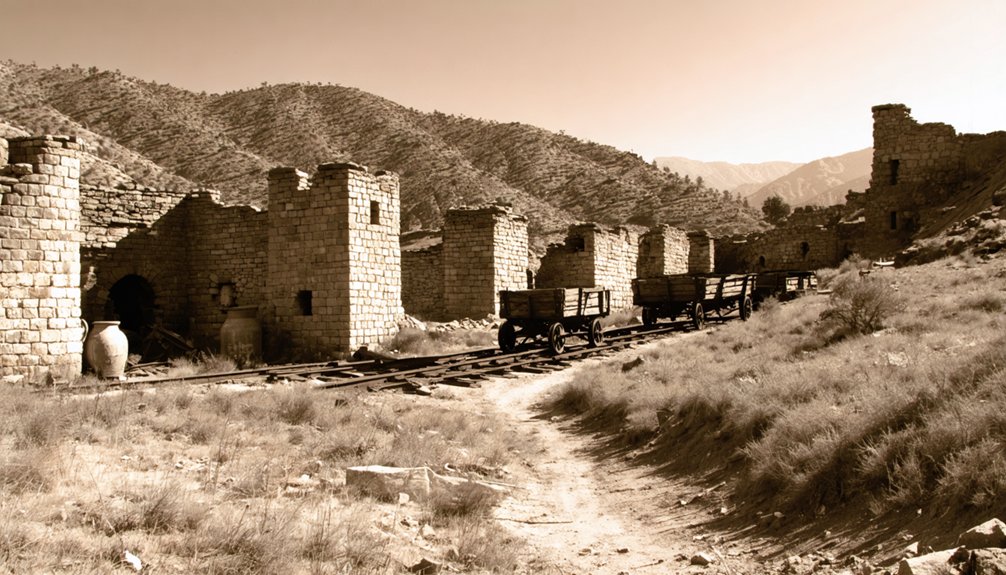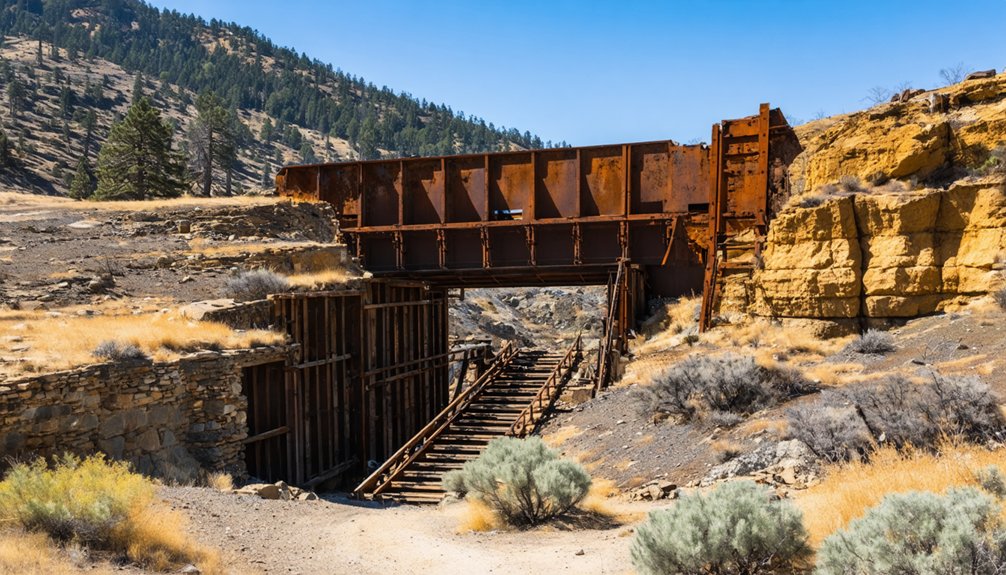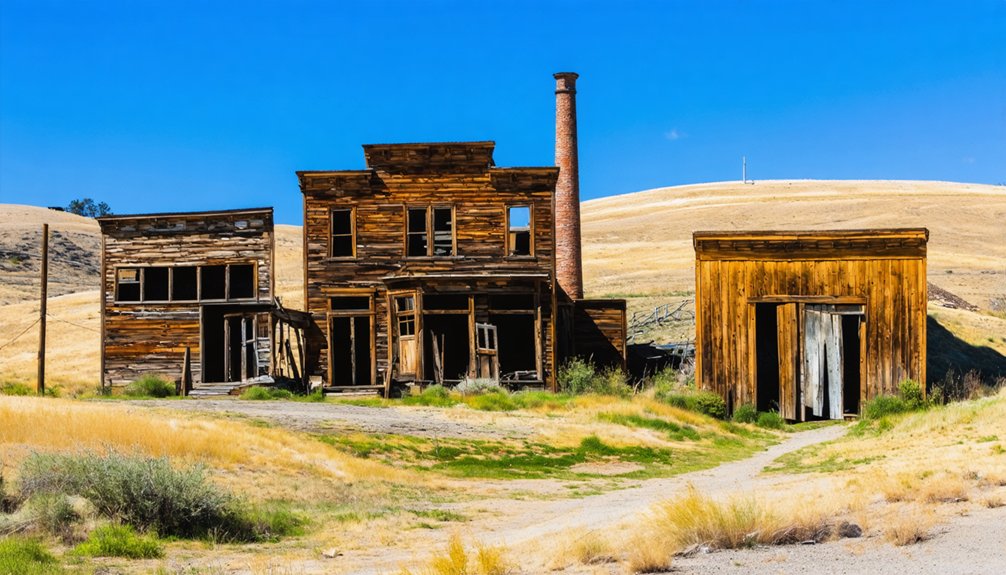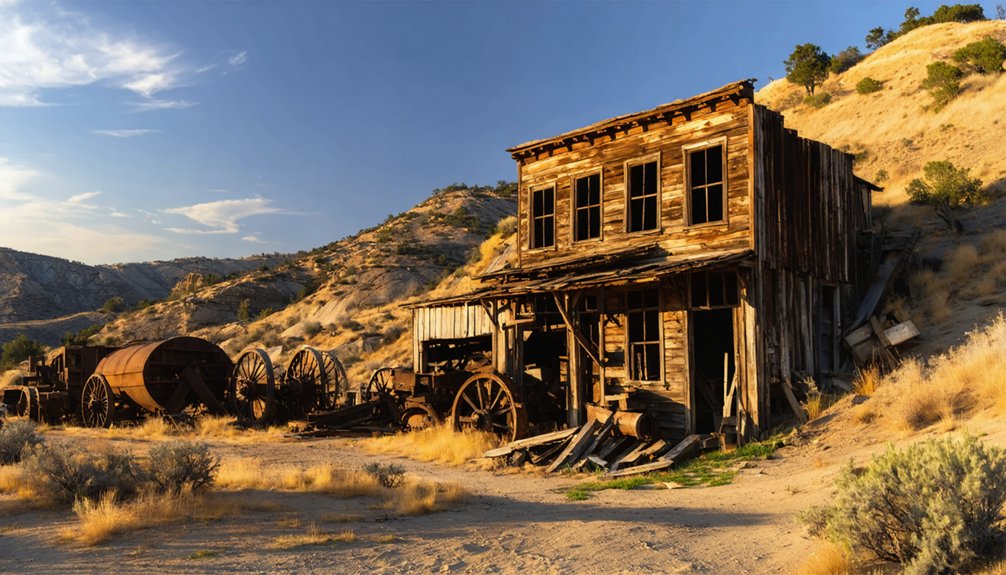Carson Hill, a Mother Lode ghost town named after James H. Carson who discovered gold there in 1848, produced California’s largest gold nugget (195 pounds troy) and approximately $26 million in precious metals. You’ll find it located 3.7 miles south of Angels Camp on Highway 49, now preserved as California Historical Landmark #274. The site’s narrow streets and abandoned mines reveal the boom-and-bust cycle that transformed this once-vibrant settlement.
Key Takeaways
- Carson Hill transformed from a prosperous mining settlement into a ghost town after operations ceased in 1942.
- The town’s abandonment occurred following a devastating mill fire and War Production Board regulations during WWII.
- Carson Hill produced approximately $26 million in gold during its operational period before becoming largely abandoned.
- Once home to California’s largest mining camp at Melones, the area experienced classic boom-and-bust mining town trajectory.
- The ghost town features narrow 10-foot streets and remnants of brush houses characteristic of its mining-era architectural landscape.
The Gold Discovery That Named a Hill
The seminal discovery of placer gold in 1848 marked the beginning of Carson Hill’s storied mining history, when prospector James H. Carson first identified the precious metal in what would later be named Carson Creek.
This initial placer mining operation quickly gave way to more sophisticated extraction when a Mexican miner named Pacheco identified gold-bearing quartz croppings atop the hill.
The discovery of these quartz veins fundamentally altered the region’s trajectory. Carson and his company of thirty men managed to extract 180 ounces of gold within just ten days of their initial discovery.
The area would eventually become part of the renowned Mother Lode belt, with extensive mining operations reaching an elevation of 1,394 feet above sea level.
James H. Carson: The Forgotten Namesake
You might recognize Carson Hill as a prominent mining location, but few visitors comprehend the complex path of its namesake, Lieutenant James H. Carson, who shifted from military service in the Mexican-American War to becoming an influential prospector.
Carson’s fortuitous gold discovery in August 1848, facilitated by indigenous knowledge and executed with a diverse party of miners, established his enduring topographical legacy despite his brief tenure in the region.
His substantial initial extraction of approximately 180 ounces per person within days of discovery represents a paradoxical historical footnote—Carson’s name became immortalized in California’s geography while the man himself failed to secure lasting wealth from his significant find. After being discharged from the Army in November 1849, Carson elected to remain in California, continuing his explorations despite the terminal illness that would claim his life just four years later.
The area where Carson made his discovery would later yield the largest gold nugget in California, weighing 195 pounds troy and valued at $43,000 when found at the Morgan Mine in November 1854.
From Soldier to Prospector
While serving as a Second Lieutenant in Stevenson’s Regiment during the Mexican-American War, James H. Carson distinguished himself through unwavering military discipline.
Unlike many comrades who abandoned their posts after Sutter’s Mill revelations, Carson completed his service before changing to prospector in summer 1848.
Carson’s methodical approach to prospecting techniques reflected his military background. After mustering out in San Francisco, he organized a company of thirty men, mainly Mexican miners, and ventured to what would become Carson Creek.
There, guided by indigenous knowledge, he extracted approximately 180 ounces of gold per person within just ten days—an extraordinary yield demonstrating his analytical capabilities.
When returning in 1849, Carson witnessed the alteration of his discovery into a burgeoning settlement, his legacy already embedded in the California landscape through toponymic recognition.
His earlier role as commissary sergeant at the 10th Military District Headquarters in 1847 had prepared him for the logistical challenges of organizing mining operations in the wilderness.
Gold Discovery Legacy
Historical obscurity often overshadows pivotal figures in California’s gold rush narrative, with James H. Carson exemplifying this phenomenon.
Despite lending his name to Carson Creek, Carson Hill, and the surrounding settlement, his foundational role remains underappreciated relative to the area’s $26 million gold production.
Carson’s military background as a Second Lieutenant in Stevenson’s Regiment informed his methodical leadership of a diverse 30-man prospecting company.
Their remarkable extraction of 180 ounces per person within ten days catalyzed the region’s transformation. His explorations with General B. and Lt. W.T. Sherman expanded the gold rush’s geographical parameters throughout Calaveras County.
After several unsuccessful years of prospecting in other regions, Carson eventually returned to Carson Creek where he had initially found success before his untimely death in 1853.
Carson’s legacy impacts extend beyond initial discovery; his systematic approach to resource identification established a template for subsequent mining ventures, though historical records have privileged production quantities over the individual who first revealed the area’s potential.
Wealth Without Reward
Irony pervades the fate of James H. Carson, who despite lending his name to an area that yielded massive unclaimed treasures, remained significantly devoid of personal wealth.
You’re witnessing the paradox of a discoverer who never capitalized on his momentous find.
Carson’s forgotten fortunes represent a historical enigma among Gold Rush narratives:
- Abandoned his initial discovery site in fall 1848, forfeiting potential wealth
- Returned in 1849 to find the landscape transformed by subsequent miners
- Failed to accumulate substantial capital despite pioneering the discovery
- Maintained modest economic status while others profited from his namesake mines
- Contributed historical documentation rather than amassing monetary gain
His legacy exemplifies the capricious nature of mineral wealth—the very hills bearing his name produced a 195-pound gold nugget in 1854, yet Carson himself never experienced commensurate prosperity.
Mining Boom and the 195-Pound Gold Nugget
Carson Hill’s extraordinary mining boom began in 1848 with James H. Carson’s discovery of gold in the creek that would bear his name.
The area’s true potential emerged when John Finnegan located the main Carson Hill Mines in 1856, initiating extensive ore extraction operations.
The Morgan Mine epitomized the region’s phenomenal wealth, yielding approximately $3 million in just two years through rudimentary mining techniques.
Miners could extract gold through simple blasting rather than elaborate excavation methods.
The apex of Carson Hill’s notoriety came in November 1854 with the nugget discovery that astonished California—a 195-pound troy gold block valued at $43,000.
This mammoth specimen, alongside numerous 14-pound lumps, cemented Carson Hill’s reputation as one of California’s most productive mining districts, ultimately generating nearly $26 million in precious metals.
The discovery significantly transformed Calaveras County and attracted numerous fortune-seekers to the region.
Melones: The Mexican Mining Camp

Nestled on the southern slopes of Carson Hill near upper Carson Creek lay Melones, one of the most culturally distinctive mining settlements of California’s gold rush era. This primarily Mexican enclave existed for just over a year but made a significant impact on regional mining techniques.
You can attribute the camp’s name to gold nuggets resembling melon seeds found in nearby waterways.
Mexican miners introduced sophisticated quartz lode mining expertise that revolutionized extraction methodologies throughout the region:
- Brush-built houses lined narrow 10-foot streets, creating a distinctive architectural landscape
- Quartz mining knowledge transferred from Mexican culture to white miners on Carson Hill
- Gambling flourished extensively among cash-flush Mexican miners
- Mining operations followed traditional Mexican organizational structures
- The community preserved cultural autonomy within the Anglo-dominated gold rush society
The Foreign Miners Act of 1850 severely impacted Melones by imposing a twenty-dollar monthly tax on non-American miners, eventually contributing to the camp’s decline.
The rich quartz lode was first proven in 1850 on top of Carson Hill, attracting more miners to the area.
Rise and Fall of a Bustling Gold Rush Settlement
You’ll find Carson Hill’s dramatic transformation from immense prosperity to near abandonment exemplifies the quintessential boom-and-bust cycle of Gold Rush settlements.
The site’s astounding wealth—yielding a 195-pound gold mass and blasts that produced $110,000 in gold instantly—created a thriving economic ecosystem that supported gambling establishments and commerce until 1942.
When the devastating mill fire coincided with the federal War Production Board’s closure order L-208, these elements converged to precipitate Carson Hill’s rapid decline into the ghost town visible today. Named after Sgt. James H. Carson who discovered Carson Creek in 1847, the area became one of the richest mining districts along Highway 49.
Overnight Wealth, Sudden Abandon
When gold was discovered in 1848 by James H. Carson, Carson Creek became the epicenter of unprecedented wealth generation. The economic trajectory exemplified the volatility inherent in transient communities built on extractive industries.
Miners employed innovative techniques that yielded astonishing returns—a single blast could produce $110,000 in gold, manifesting profound wealth disparities between successful claim-holders and laborers.
The town’s rise and demise reflected the fragility of resource-dependent settlements:
- A remarkable 195-pound gold-quartz mass discovered in 1854 valued at $43,000
- Total production reaching approximately $26 million
- Peak annual production of $937,156 in 1939
- Cessation of operations in 1942 due to War Production Board regulations
- Mill destruction by fire in 1942 accelerating abandonment
You’re witnessing a historical pattern: dramatic prosperity followed by equally dramatic decline when extraction became economically unfeasible.
Gambling Empires Disappeared
Adjacent to Carson Hill’s mining operations, the gambling economy of Melones emerged as a formidable cultural force that would define the region’s social landscape during its brief but significant heyday.
Within narrow, ten-foot-wide streets lined with brush houses, you’d have witnessed an extraordinary gambling culture dominated by Mexican miners. These establishments functioned simultaneously as residences and gaming halls, creating a distinctive cultural synthesis that earned the settlement its “Mexican Melones” moniker.
The economic impact was staggering—nearly every Mexican miner participated in games of chance, circulating immense wealth from nearby gold operations.
This gambling empire’s meteoric rise and precipitous decline exemplifies the Gold Rush‘s volatile nature. Following the Morgan Mine’s closure in 1853, Melones’ gambling establishments vanished almost overnight, leaving behind only stories of its once-vibrant gaming economy that had transformed it into California’s largest mining camp.
Geological Features and Mining Operations

Situated within the Mother Lode belt but exhibiting atypical geological complexity, Carson Hill represents a distinctive structural domain that illuminates regional gold mineralization patterns.
The site’s extraordinary wealth stemmed from intricate fault systems where multiple quartz veins—Bull, Calaveras, and Flat—contained substantial auriferous deposits. Mining operations penetrated hundreds of feet below ground, requiring sophisticated extraction techniques to navigate structural offsets reaching 100 feet.
- Pre-Cenozoic metavolcanic rocks and Calaveras Complex form the primary lithology
- West-dipping reverse faults and east-dipping thrust faults control mineralization patterns
- Three principal quartz vein systems occupy distinct shear zones
- Complex structural disruption required adaptive mining methodologies
- Both placer gold and deep vein systems contributed to Carson Hill’s exceptional productivity
This geological complexity necessitated evolution in mining techniques, transforming Carson Hill into one of California’s most significant gold-producing regions.
The Ghost Town Today: What Remains
Unlike many preserved Gold Rush settlements that maintain substantial architectural integrity, Carson Hill presents a distinctly diminished physical footprint today.
You’ll find only scattered stone foundations where bustling mills once operated, with most original structures having been burned or dismantled after the 1942 mine closures.
The ghost town remnants consist primarily of a handful of converted residential buildings on private property, lacking the “arrested decay” preservation status that protects sites like Bodie with its 170 standing structures.
Carson Hill’s archaeological significance lies in its foundational traces and surface-level artifacts rather than intact infrastructure.
Without state park designation or public access facilities, the site’s mining heritage survives mostly through historical documentation and archaeological studies, while the physical landscape remains sparsely populated and largely inaccessible to visitors.
Historical Landmark #274: Preserving Carson Hill’s Legacy

Though physically diminished as a tangible ghost town, Carson Hill’s historical significance endures through its designation as California Historical Landmark #274. This official recognition, established on May 23, 1949, represents a collaborative effort in historical preservation between the California Centennials Commission and the Angels Camp Lions Club, demonstrating essential community involvement.
The landmark commemorates:
- James H. Carson’s 1848 gold discovery that initiated the area’s mining prosperity
- The 195-pound troy gold nugget unearthed in 1854—California’s largest
- The staggering $26 million gold production during its operational zenith
- Carson’s pioneering legacy despite his unfortunate demise in poverty
- The site’s elevation within California’s Gold Rush narrative
You’ll find the marker 3.7 miles south of Angels Camp on Highway 49, preserving the memory of this once-thriving mining epicenter.
Frequently Asked Questions
Can Visitors Pan for Gold at Carson Hill Today?
Despite Carson Hill’s historical $26 million gold yield, you can’t engage in recreational gold panning there today. The area’s visitor experiences are limited by private property restrictions and active quarry operations.
Were There Any Famous Shootouts or Crimes in Carson Hill?
Historical records don’t document any famous Carson Hill shootouts or notable Carson Hill crimes. While gambling thrived in nearby Melones, the area’s conflicts manifested primarily as legal mining disputes rather than violent confrontations.
What Happened to the 195-Pound Gold Nugget?
Like California’s dreams, the 195-pound gold nugget vanished into obscurity. You won’t find records of its fate in mining history—it was likely melted down immediately, as freedom from documentation prevailed in Gold Rush capitalism.
Are There Guided Tours or Museums Dedicated to Carson Hill?
You won’t find dedicated guided experiences or museums specifically for Carson Hill. Historical exhibits appear in regional museums, with informational plaques and landmark #274 serving as primary interpretive resources for autonomous exploration.
Did Any Notable Historical Figures Visit Carson Hill?
While many expect famous visitors to flock to significant gold discoveries, Carson Hill’s historical significance primarily stems from James Carson himself, the Angel and Murphy brothers, and mining figures—not nationally recognized celebrities.
References
- https://www.calaverashistory.org/carson-hill
- https://en.wikipedia.org/wiki/Carson_Hill
- https://www.ghosttowns.com/states/ca/carsonhill.html
- https://westernmininghistory.com/mine-detail/10310598/
- https://ohp.parks.ca.gov/ListedResources/Detail/274
- https://www.youtube.com/watch?v=-jeEu1kTChM
- http://malakoff.com/goldcountry/carsonhi.htm
- http://explore.museumca.org/goldrush/dist-carsonhill.html
- https://www.uticawater.com/1851-gold-rush-in-calaveras-county
- https://www.hmdb.org/m.asp?m=6848



